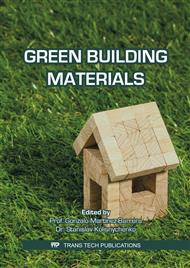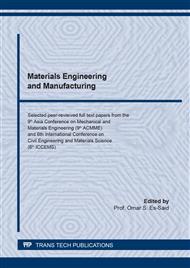p.158
p.163
p.174
p.179
p.186
p.195
p.202
p.207
p.214
Physical Properties of Sustainable Concrete Bricks with Glass and Polyethylene Terephthalate Scales Wastes as Replacements for Coarse Aggregate
Abstract:
In order to improve the sustainable construction in Peru, throughout the recycling of non-biodegradable materials, a study of the influence of glass and Polyethylene terephthalate (PET) wastes in the physic properties of concrete bricks was carried out. They were made with a 1:5:2 cement, fine aggregate, and waste relation. Three proportions were studied named P-01, P-02, and P-03. Each proportion had a different content of glass and PET wastes, as a result, it was found that the average brick’s absorption was increased with PET wastes and it was reduced with glass wastes. On the other hand, the compressive strength value increased with glass wastes and it was reduced with PET wastes. Finally, it was found that P-02 was the most efficient concrete brick proportion to develop a sustainable construction, obeying the requirements of the Peruvian national building regulations.
Info:
Periodical:
Pages:
186-191
Citation:
Online since:
October 2021
Price:
Сopyright:
© 2021 Trans Tech Publications Ltd. All Rights Reserved
Share:
Citation:



